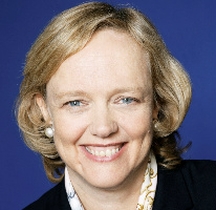New technologies combined with traditional strengths that cover hardware, software and services, will continue to give HP a lead in the emerging world of the ‘New Style of IT’, according to HP CEO Meg Whitman.
In her keynote at the HP Discover event in Barcelona, Whitman said that HP is uniquely placed to provide solutions in the rapidly changing world of enterprise IT.
“We have a unique perspective because we helped to build the IT world of today and are helping to create the IT world of tomorrow,” said Whitman.
“We are unique because we are equally strong in infrastructure, software and services, from security to big data. We are uniquely qualified because invention and innovation are heritage values for HP – they are in our DNA.”
Whitman said that IT has become more important than ever, and “remains the defining change agent of our time.”
“IT is now a critical strategic factor in determining whether your organisation will win or lose in the market place,” she warned.
However, Whitman emphasised that there were significant shifts in the nature of IT for business. CIOs are now on the bridge of organisations with the CEO “scanning the horizon”, she said.
“There is also a big shift around the way technology is consumed, delivered and paid for.”
“These shifts demand what we call the New Style of IT, which is in reality, a new style of new style of business driven by IT.” But these shifts were also creating “new kinds of pressure on businesses and IT professionals.”
Whitman outlined the way that demand for services was driving massive growth in service provider needs and data centres.
“By 2016 research suggest that 75% of IT environment will be deployed in either a private, managed or public cloud and that is going to call for data centres that expand to fit that scale.”
“A conservative estimate is that large cloud and web service providers will require an installed base of 8-10 million new servers within just three years.”
“The price tag to build these is between $10-20 billion.”
Current strategies are unsustainable, in terms of space, energy or cost she said.
Today, Whitman quoted, data centres consume about 2% of the world’s energy. By the end of the decade, that will rise to 30%, if a more efficient technology is not found.
“This is simply not sustainable,” she stated.
“HP,” said Whitman, “is looking ahead to see how we can revolutionise the energy economics of the data centre.”
Whitman cited HP’s Moonshot server range of ultra-dense, cartridge-based server systems that boast impressive savings in terms of space, power consumption and price, as a measure of its commitment to changing the current approach.
“HP is the only company with the breadth and depth of innovative products, software and services to help you succeed in this new reality.”
She said that approximately 40% of Fortune 100 companies are using HP converged cloud solutions and services.
“We have the cloud that enterprises rely on,” she stated.
“No other company has the strengths and experience in hardware, software and services. We make it, we back it and we service it.”
This claim is borne out to a certain extent by both Gartner, which places HP high in its Magic Quadrant evaluation system for private cloud solutions, and by Forrester, which describes HP as the “sole leader” in this area.
Building upon these strengths, Whitman said that HP is also looking deeper to the fundamental architecture of computing which is encountering limitations in meeting current and future demand, based as it is on architectures that are decades old.
The current fundamental computing architecture of processor, memory and storage has not changed much in 60 years, argued Whitman, and is increasingly inefficient.
“We need a computer architecture for the Big Data Age, one that can store exponentially more data.”
“What is coming next is a whole new architecture based on two revolutionary technologies created by HP labs.”
These technologies are memristor and photonics.
Memristor, explained Whitman, are “is a high performance, low cost, non-volatile memory created by HP Labs that will revolutionise how we store data.”
It is envisaged that memristor technology could one day replace current RAM, Flash and solid state disk technologies, but also provide a basis for new types of processors where memristors replace traditional transistors. It was reported in 2012 that memristors could provide access times up to 100 times faster than current flash memory while using just 1% of the power. However, while initial production ready estimates were for around 2014, it is now more generally accepted that the market is unlikely to see memristor technology commercially available until 2018.
“Photonics uses light in optical fibres instead of electrons in copper wires. We use microscale lasers on microchips to convert data signals from electrical signals to light and back again,” said Whitman.
Transfer speeds of 6TB/s over photonic interconnects have been achieved, said Whitman.
It is envisaged that such interconnects will provide a much faster interface between processors, memory and storage in the future, which, boosted by faster technologies themselves, such as that provided by memristors, will revolutionise what computers can do in terms of programmability at the hardware level and sheer throughput.
“We will stay ahead of demand not by evolving old technology but by fundamentally changing the game,” asserted Whitman.
Another area that was of particular interest for HP, said Whitman, was around 3D printing. She said that efforts were being focused in two key problem areas for the technology, speed and quality.
Whitman said that all of these qualities, from traditional strengths, to leadership in emerging areas and pioneering new technologies, will secure HP’s future and see it continue to lead and build the IT world of tomorrow.
“We want to be the best technology provider, the best technology partner on earth,” she said.
TechCentral Reporters






Subscribers 0
Fans 0
Followers 0
Followers